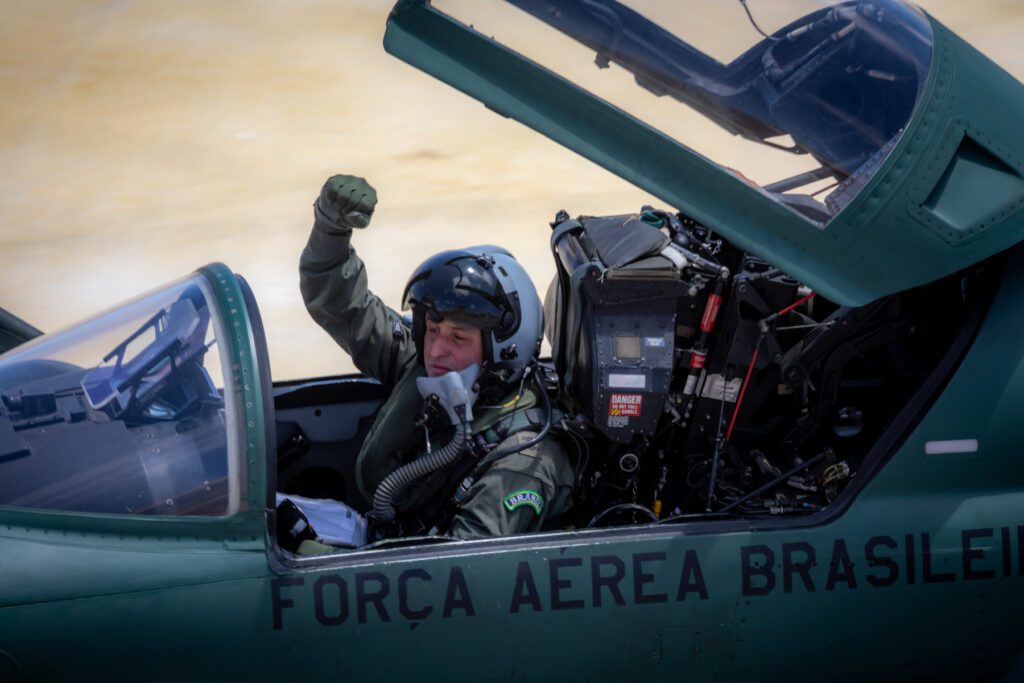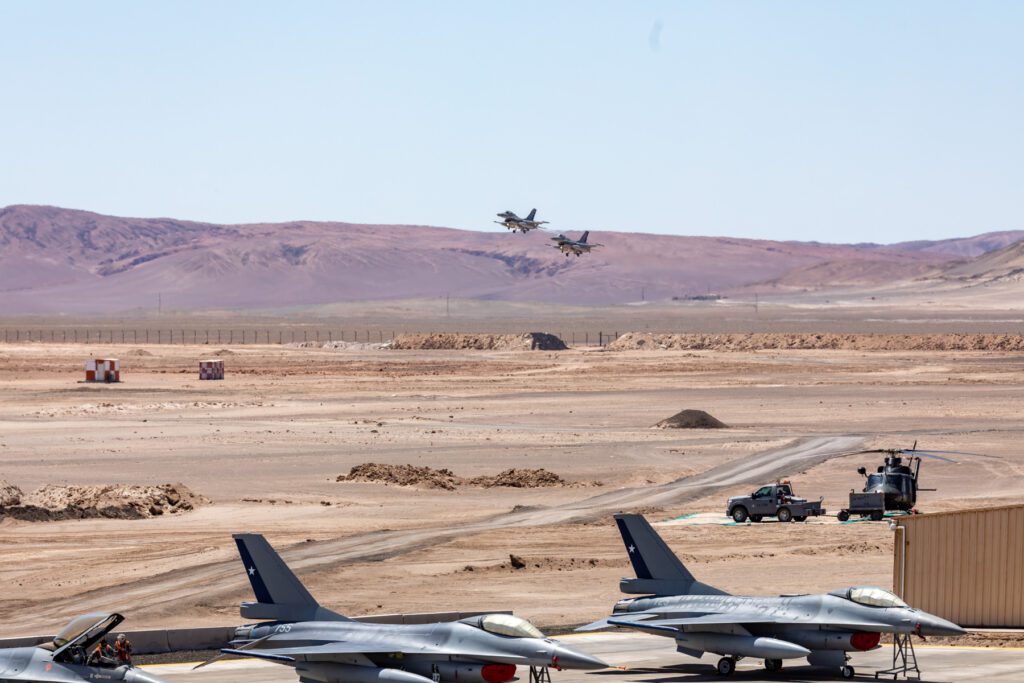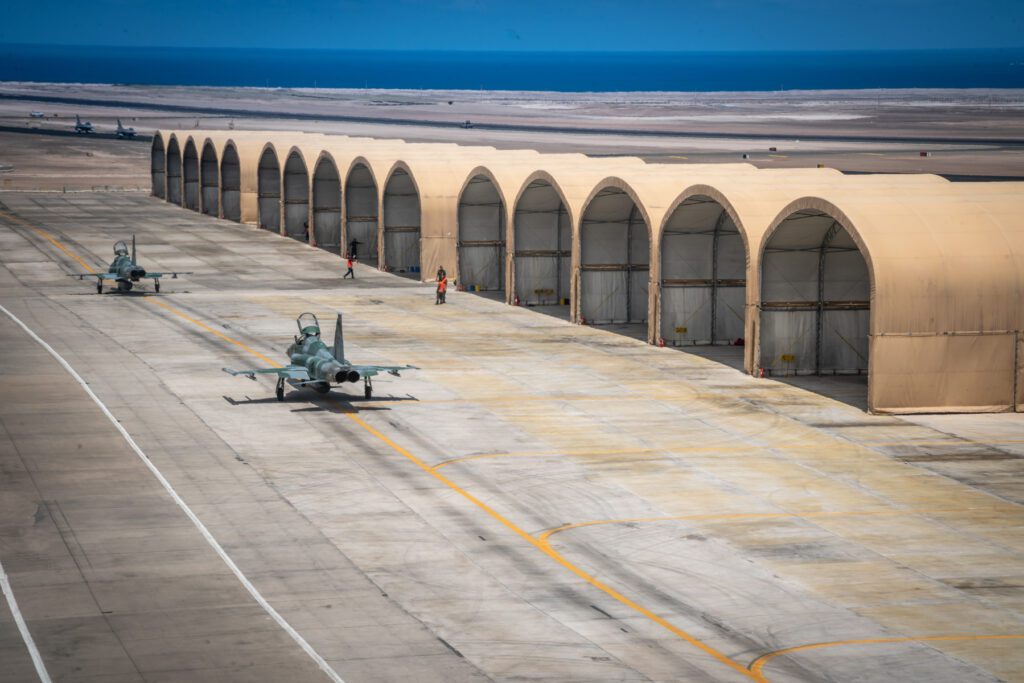Composite Air Missions (COMAO) are executed in the Salitre 2022 Multinational Exercise, involving aircraft and crews from Brazil, Chile and Argentina
Air Force Agency, by Lieutenant Flávia Rocha E Major Oliveira Lima
In a fictitious conflict scenario, missions involving up to 40 aircraft seek to increase interoperability among Air Forces participating in the Salitre 2022 Multinational Exercise, which takes place in northern Chile and is considered one of the largest air training exercises in South America.
This is the context experienced in the third phase of the combined air combat training. In this stage, called Live Exercise (LIVEX), the crews execute, during five days, the composite air missions, also called COMAO (Composite Air Operation), which involve Squadrons in several simultaneous actions.
[In the simulated war, the coalition of countries formed by Argentina, Brazil and Chile, based in Antofagasta, faces an opposing force formed by Chilean F-16, F-5 Tiger III and A-29 Super Tucano fighter planes, operating from Los Cóndores Air Base, in Iquique.
On the friendly side, aircraft from the Brazilian Air Force (FAB) F-5M and KC-390 Millennium; the Chilean Air Force (FACh) F-16, F5 Tiger III and A-29 Super Tucano; and the Argentine Air Force (FAA) IA-63 Pampa III and A-4R Fightinghawk; as well as Chilean combat support aircraft FACh C-130 Hercules, KC-135E Stratotanker and MH-60M Black Hawk and Bell 412 helicopters are participating.

Major Aviator Freitas, from the First Squadron of the Fourteenth Aviation Group (1/14th GAV) – Pampa Squadron, had the responsibility of representing FAB as the Exercise’s Mission Commander, leading 30 aircraft on the second day of air combat. On the occasion, the Brazilian Mission Commander was able to apply all the teachings and experiences throughout his operational career.
According to the Major, the mission was a success. “I also attribute this result to the pilots of the Pampa Squadron and the 1st Fighter Aviation Group (1st GAVCA) who demonstrated high operational competence from mission planning to flight execution,” he said.
[Click here to download the original image] Still according to the Officer, the outcome demonstrated to the participating countries that the fighter pilots of both F-5M Squadrons are well trained and ready to fulfill the mission of maintaining the sovereignty of Brazilian airspace. The FAB Mission Commander also emphasized the pride of achieving air superiority in the first 15 minutes of combat, in Monday’s flight (October 17). “In the mission, we allowed the A-4, IA-63 and A-36 attack aircraft from Argentina and Chile to carry out their simulated attacks without any threat,” he celebrated.

[Click here to download the original image] As for Captain Aviator Ticianelli, also from the Pampa Squadron and Mission Commander, he reinforced that this phase contemplates the coordination among the participants to accomplish several types of missions, such as attack, escort, suppression and air defense and in-flight refueling. “In this phase, there is the role of the Mission Commander, who are the mission coordinators, whose main function is to define tactics and adjust responsibilities to ensure the safety of the operations and also to ensure that the objectives of each participant are met,” he added.
“The focus is to get all the participating countries to be able to act together with the same doctrine and the same combat philosophy. Each day a different country will be the coordinator of the mission, so that we can exchange experiences and knowledge,” continued Captain Ticianelli.

Besides the Mission Commander and the other fighter pilots, another key player in this scenario is the aircraft maintenance personnel. Petty Officer Anderson Medeiros da Silva, of the Santa Cruz Air Base Logistics Group (GLOG-SC), points out that COMAO missions in Salitre are about a theater of operations on foreign soil that has its own adversities. “Immediately, we can hone our logistical, operational and terrain adaptability readiness-response capabilities. It follows that an operation of this magnitude provides an excellent opportunity for a possible course correction in our mode of operation, given the exchange of experiences with maintainers from other air forces, in addition to further integrating our maintenance teams,” he says.

“Added to this is the joy of strengthening even more our fraternal ties with the people of Chile and Argentina, as well as the United States, Canada, Peru, Mexico and Uruguay, concluded the Suboficial.
Photos: FACh and Petty Officer Joelson Nery / CECOMSAER *** Translated by the DEFCONPress FYI Team ***
